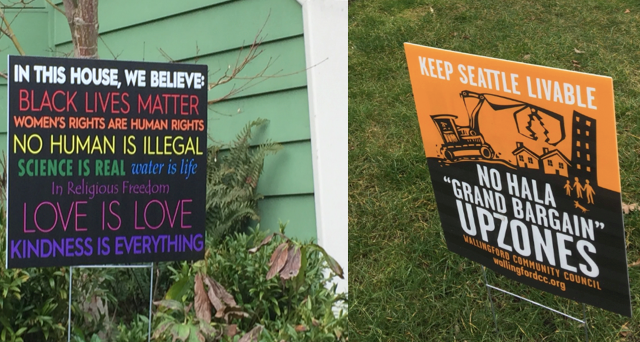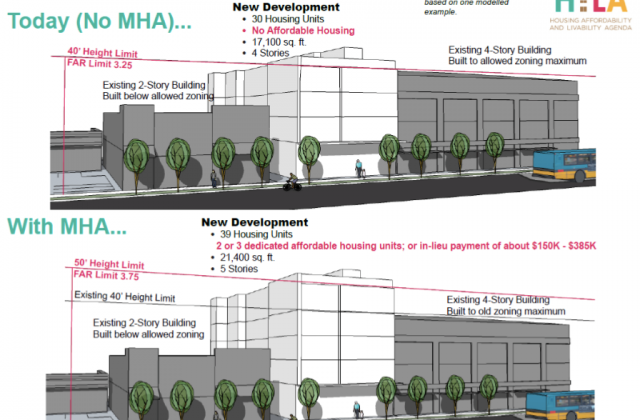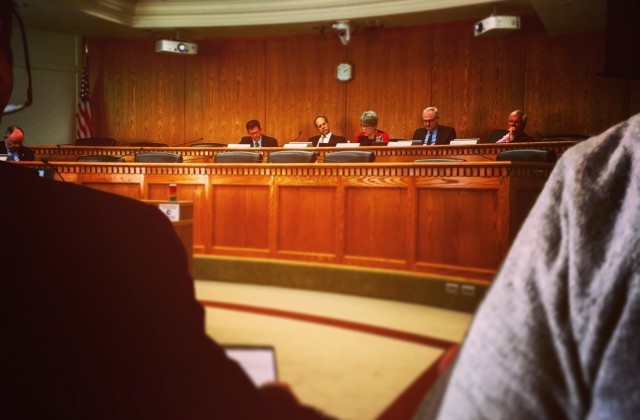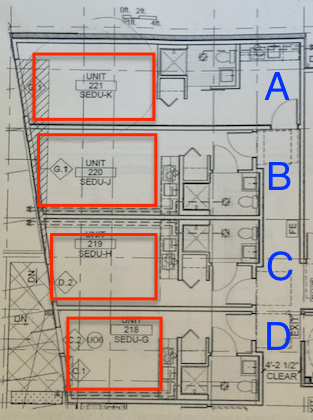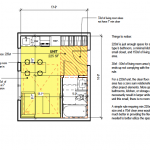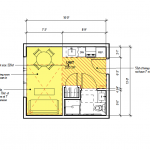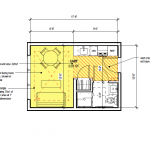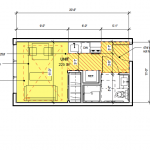“In My Space!:” The Evil of Banality in Seattle
A picture. A thousand words. You know the phrase. And there have been so many pictures lately, especially of signs. I’ve overheard the conversations about “my favorite sign” from the late protest against all things Donald Trump. The convulsion of anxiety and emotion and protest is unlike anything I’ve seen in quite awhile. Usually this kind of upset precedes a military action, at least over the last 25 years. There is the deadline, the build up, the protests, the action, and then the resolution. Heads are spinning in Seattle, especially over the President’s actions on immigration.
What I find interesting and peculiar about the meltdown in Seattle is how the outrage is coupled with excitement. Elected officials scurry from place to place, set up microphones, and then attempt to outdo each other in their condemnation of the immigration orders. Many words are said, pictures are taken, promises are made, and the cheers and sense of pride and self-satisfaction fill the room and the airwaves. I find very little distinction between the kind of emotional energy surrounding these protests or the sense of pride that people here had when Obama was elected and a marriage equality initiative passed and the enthusiasm people here expressed when the Seahawks won the Super Bowl.
Notwithstanding the very real chaos unfolding as one regime replaces another in our nations capitol, I find all this disturbing for a few reasons. First, while the Mayor and Council do their best to emote and quote and ambulate around all manner of totems, they have encouraged and supported moves over things they actually control that are in direct contradiction to the sentiments they express in their performances about immigration. Right here, in our own land use and building codes are all manner of limits and restrictions to housing for people — all kinds of people — who want to live in Seattle.
Second, I find it ironic if not just plain hypocritical, that the same Mayor and Council who claim Seattle to be a “sanctuary city” think nothing of debating sweeping homeless people out from under bridges and other public areas. As I’ve said before, what are homeless people but domestic refugees. Yet, our local policy is as fearful and xenophobic as anything Trump said while campaigning or in the last week as President.
Finally, I know that many people who have the signs against upzones in the U District were in the streets last week. I know that the person who has the sign about “Love is Love” very likely would oppose a microhousing project if it were going in next door, or down the street. I know that the sentimentality for far off refugees or people being held in airports or facing deportation or the uncertainty of the next months ahead is not shared for new workers and people moving to Seattle who need a place to live. I know what they’ll say: “Oh c’mon! It’s different. It’s different.” Of course. You know. Parking. Views. Height. Bulk. Scale.
I’m still trying to figure out how it’s different. How is it different from the President’s actions to slam the door to new housing projects that will benefit many people coming here, including people from other countries who have found employment here. How is it different from the President’s actions to actively campaign against people who are living in tents and in cars because they have no money, are struggling with addiction, or simply have no other options left. What if all these refugees we’re supposed to provide sanctuary actually show up. Where are they supposed to live? Where will they park? Won’t they block your view of the Space Needle? I’ve seen this all before. High and mighty rhetoric for the television cameras and the national press, opposition to wars and foreign adventures, but right around the corner, well, “It’s different.” Those people in are “in my space.”
Sightline Corroborates Our Points About Mandatory Inclusionary Zoning
I’ve been after the Sightline Institute for a long time now urging it to abandon it’s support for Mandatory Inclusionary Zoning (MIZ). Last year they hired one of the smartest guys in town, Dan Bertolet, who I had worked with before challenging the City’s housing need numbers. Since then I’ve been after Bertolet to finish his math and finally tell us what was at the bottom of the page. He finally finished, and he’s come to the same conclusion we did a long time ago: implementing the current MIZ scheme is “worse than doing nothing.”
You can read his whole post which is linked below. The reason Sightline’s opinion matters is because we didn’t put them up to this analysis, he arrived at this conclusion on his own. I think Bertolet has known this thing won’t work for a long time, at least as long as me. Sightline is still clinging to the notion that MIZ can “work” if the City gets the math right. I think anyone looking at the idea — add costs to a product to make it cheaper — makes no sense. And MIZ is not “a smart balance of developer requirements and additional building capacity;” it’s a racket to squeeze money from market rate development and pour it into really inefficient non-profit housing, a move that will increase overall prices to make up for the new costs.
So now that a think tank not in the pocket of greedy developers has almost decided that MIZ is infeasible because of math mean the City will rethink it’s position? I doubt it. But I asked them anyway. Here’s my letter to City staff working on this. We’ll see if we ever get a response. I’m not holding my breath.
—————————–
Hello,
Hi Roger,
There will likely be a response coming in some form to the article. I don’t want to start putting a response in an email chain, however I do want to point out, since you mention me by name, that I have not stated MHA will increase overall housing prices, and I’m not sure where you are getting that.
Thanks,
Geoff
Hi Geoff,
How would [paying fees] not increase the rate of the, increase the price of the market rate units on that development. And that’s a great question. And it is, um, a trade off and I think part of the policy and it may be the case that the market rate units have to, to some extent subsidize the inclusion of the affordable units and that it is a valid way to view the program. But uh, the proposal and the fees that are being proposed and set are such that we feel pretty confident that development will still be feasible and we would work with the development community that we wouldn’t be over impacting feasibility (the full exchange is in this video starting at about 49:45).
And Geoff, you are mentioned by name because you are accountable for this work. It’s not like you are some anonymous cog. We also have the Mayor on video saying that the fees are a “penalty.”
Preservation Tax Exemption: An Efficient and Sensible Way to Preserve Older Housing
Yesterday, in Olympia, I gave some comments to the Senate Human Services, Mental Health & Housing about Senate Bill 5182. The proposal was offered in a previous legislative session but failed to pass. I think this proposal called the “Preservation Tax Exemption,” is a great idea if it’s done correctly. The idea is to expand the concept behind the Multifamily Tax Exemption (MFTE) Program to existing buildings that offer lower rents. Owners of those buildings could seek tax exemption for keeping a portion of units in their building restricted to levels at 50 to 60 percent of Area Median Income (AMI). This could allow some breathing room for owners of older buildings who could use the tax relief to better maintain their buildings and avoid having to sell them to new owners who would have to dramatically raise rents to recover their investment.
Here’s the City of Seattle’s description of the program:
Preservation Tax Exemption
Establish local option for a 15-year tax exemption for property owners in the private market who agree to set aside 25 percent of their buildings for low-income tenants (earning less than 50-60 % of area median income) to maintain affordability for lower income community members, improve housing health and quality for very low-income residents and prevent displacement of long time community members.
Often comments in front of Committees get squeezed into a minute or even less, but here’s the statement I handed to the Committee.
——————————-
I am Roger Valdez, Director of Smart Growth Seattle, an advocacy organization for more housing choice and opportunity through housing development of all types in every neighborhood and for every level of income in Seattle.
We are very much in favor of the principles embodied in Senate Bill 5182. There are many buildings in Seattle that because of their age, condition and location, offer lower rents to people who need housing. As these buildings age, owners often pass the savings of deferred maintenance on to their tenants in the form of ongoing low rent or smaller increases over time.
However, this tenant friendly move, ironically, can plant the seeds for disruption for tenants. There comes a point when an owner is confronted with significant costs to catch up with deferred maintenance and frequently these owners feel compelled to sell their property because of the costs of maintenance, taxes, utilities and other costs. This results in the all too familiar stories on the front page of the Seattle Times that we could all write in our sleep with a headline like: Vulnerable Individual Faces Displacement After Building Sale.
The City of Seattle has had tremendous success in creating real rent savings for real human beings who are renters through the Multifamily Tax Exemption (MFTE) Program. The MFTE program has used a deferral of some tax revenue (costing the median single-family home about $10 a year) to create thousands of affordable units. This is a very low-risk high-yield investment by the City in affordability. The positive impact on households is significant and real, creating savings for those individuals and families that allow saved money to be used for tuition, day care, or paying down debt. Expanding this program to existing, older, more affordable buildings can avert the usual headline and prevent real pain.
I would caution the Committee and the Legislature to keep in mind that this program only works if it is a real incentive. Dialing up rates of inclusion and dialing down Area Median Income (AMI) will not create more affordable units at 30 or 40 percent AMI. On the contrary, such a move would create fewer affordable units at 50 or 60 percent. Please don’t dial inclusion up or AMI down. In fact, many building owners and developers say this level of inclusion is already too high.
Also I am wary of language in Section 9.1. (f) allowing the City, “additional requirements to reduce displacement of very low-income household tenants.” I don’t want the City of Seattle to have any more authority than they absolutely need, and no jurisdictions, including the City, have developed a quantifiable measure of “displacement.” I urge you to strike that section. In the following section I also don’t think language on “height, density, public benefit features” etc. in subsection 9. 2. (b) is necessary. I urge you to strike those specifics.
Finally, sections 10 and 11 seem overly prescriptive as do parts of sections 15 and following. Please consider rewriting and striking some of this language.
A Letter from the Governor and Our Response
At last week’s meeting of the Affordable Housing Advisory Board (AHAB) a letter was presented to the group — AHAB “advises the Department of Commerce on housing and housing-related issues” — from Governor Jay Inslee. The letter was encouraging because it showed an apparent appreciation by the governor that costs from zoning and planning requirements are slowing down the production of housing. I think the Governor, though, was thinking about subsidized low-income housing produced by non-profits. Here’s the letter and our response below. I am hopeful that our voice will be heard in whatever the process is to respond to the Governor’s request to find efficiencies and pass those savings on to consumers who need housing.
——————
Here’s our response to the Governor the attachments referenced are linked below the letter.
California Affordable Housing Cost Study
California Legislative Analysts Office (LAO) Study
Bending the Cost Curve on Affordable Rental Development by the Urban Land Institute (ULI)
Tomorrow at CCAB: Making Some Choices on Smaller Spaces
Tomorrow at the latest meeting of the Construction Code Advisory Board (CCAB) we are closing in on making some decisions about whether to loosen some of the restrictions on small apartments. I’ve already gone over the details of the issues in a previous post. But what it comes down to is that as unit sizes get down toward the minimum 220SF mandated by the City, it gets more difficult to program those units AND meet the building code requirement of having a 150SF “living room.” I’m proposing to the CCAB that we abolish all but the age old 70SF requirement for a room which has long been in code. That would mean that only 70SF in a unit would have to be what I’m starting to call “open space,” that is unprogrammed space with nothing in it or on it (i.e. refrigerator, closet, stove etc). This would be the best outcome.
As expected, David Neiman has been a star, producing good visuals to help the Committee get down to the basic issue: we leave things the same, create some percentage based allocation from non “living room” space to the required 150SF of living space, or get rid of the 150SF requirement all together. Here are six different options Neiman put together with the hatched areas being the areas that don’t count toward the 150SF requirement.
Here’s the text of my recommendation and my attempt at a amendment to the rule. From e-mail.
—————————————
Hello Jenifer,
SECTION 1208
INTERIOR SPACE DIMENSIONS
***
1208.2 Minimum ceiling heights. Occupiable spaces, habitable spaces and corridors shall have a ceiling height of not less than 7 feet 6 inches (2286 mm). Bathrooms, toilet rooms, kitchens, storage rooms and laundry rooms shall have a ceiling height of not less than 7 feet (2134 mm).
Exceptions:
- In one- and two-family dwellings, beams or girders spaced not less than 4 feet (1219 mm) on center shall be permitted to project not more than 6 inches (152 mm) below the required ceiling height.
- If any room in a building has a sloped ceiling, the prescribed ceiling height for the room is required in one-half the area thereof. Any portion of the room measuring less than 5 feet (1524 mm) from the finished floor to the ceiling shall not be included in any computation of the minimum area thereof.
- The height of mezzanines and spaces below mezzanines shall be in accordance with Section 505((.1)).
- Corridors contained within a dwelling unit or sleeping unit in Group R occupancy shall have a ceiling height of not less than 7 feet (2134 mm).
- Ceiling height in the means of egress shall comply with Section 1003.2.
Notwithstanding the exceptions to Section 1208.2, protruding objects in circulation routes in spaces required to be accessible shall comply with Chapter 11 and ANSI A117.1 Section 307.
1208.2.1 Furred ceiling. Any room with a furred ceiling shall be required to have the minimum ceiling height in two-thirds of the area thereof, but in no case shall the height of the furred ceiling be less than 7 feet (2134 mm).
1208.3 Room area. Every dwelling unit shall have no fewer than one room that shall have not less than 120 square feet (13.9 m2) of net floor area. Other habitable rooms shall have living space a net floor area of not less than 70 square feet (6.5 m2).
Exception: Kitchens are not required to be of a minimum floor area.
1208.4 Efficiency dwelling units. An efficiency ((living)) dwelling unit shall conform to the requirements of the code except as modified herein:
- The unit shall have a living room of not less than 220 square feet (20.4 m2) of floor area. An additional 100 square feet (9.3 m2) of floor area shall be provided for each occupant of such unit in excess of two.
Interpretation I1208.4: The required square footage shall not include built-in equipment that extends from floor to ceiling such as wardrobes, cabinets, kitchen units or fixtures.
- The unit shall be provided with a separate closet.
- The unit shall be provided with a kitchen sink, cooking appliance and refrigeration facilities, each having a clear working space of not less than 30 inches (762 mm) in front. Light and ventilation conforming to this code shall be provided.
- The unit shall be provided with a separate bathroom containing a water closet, lavatory and bathtub or shower.
